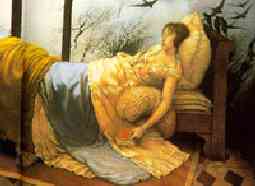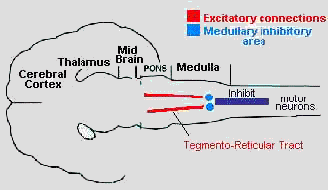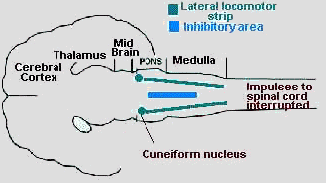

6 of 8
 Why Don't We Act Out Our Dreams ?
Why Don't We Act Out Our Dreams ?
Imagine what 'catastrophe' would be if, during sleeping
and dreaming, we wouldn't have brain mechanisms which work to inhibit our
movements and actions!
When we are sleeping, we have an adaptative mechanism that protect us from ourselves or from injuries to other people. The same mechanisms of the brain stem that control the sleep processes of the forebrain also inhibit the spinal motor neurons, preventing the descending motor activity from expressing itself as actual movement.
 Systems that inhibit movement in REM sleep. A. In normal REM sleep the pons strongly activates the inbibitory center in the medulla. The midline inhibitory zone in the pons inhibits the lateral locomotor strip (not shown here, see next figure). The result is complete paralysis. B. In REM sleep without paralysis the lesions break the connections from the pons to the locomotor strip and to the medullary center. |
 In REM sleep the pons is activated, exciting the medullary inbibitory area by projections (tegmento-reticular tract) which connects the pons to the inhibitory center. The medullary center inhibits the motor neurons and gives rise to atonia. |
 A lateral locomotor strip, down the outside of the brain stem, plays an important role in the reduction of motor drive. It is connected to structures in the spinal cord. In REM sleep the pons stimulates the inhibitory zone, turning off the locomotor strip and shutting down motor drive. |
People who act out during their dreams have a rare disorder known as REM sleep behavior disorder. These people often sustain repetead injuries and even their brother, siters, spouses and husbands have fallen victims to their nocturnal failings. The basis for this REM disorder seems to be a disruption of the brain stem systems that normally mediate REM atonia (Berar, 475).
Experimental lesions in certain parts of the pons can cause a similar condition in cats. During REM periods, they may seem to chase imaginary mice or investigate invisible intruders (Bear).
Author: Silvia Helena Cardoso, PhD. Psychobiologist, master and doctor in Sciences by the University of São Paulo and post doctoral fellowship by the University of California, Los Angeles. Invited Professor and Associate Researcher of the Center for Biomedical Inofrmatics, State University of Campinas (Unicamp), Brazil. Email:
Translation: Silvia Helena Cardoso
Center for Biomedical Informatics
State University of Campinas, Brazil
Copyright 1997 State University of Campinas